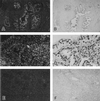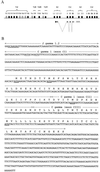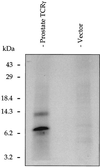High expression of a specific T-cell receptor gamma transcript in epithelial cells of the prostate
- PMID: 10430935
- PMCID: PMC17772
- DOI: 10.1073/pnas.96.16.9287
High expression of a specific T-cell receptor gamma transcript in epithelial cells of the prostate
Abstract
We have identified expression of T-cell receptor gamma chain (TCRgamma) mRNA in human prostate and have shown that it originates from epithelial cells of the prostate and not from infiltrating T-lymphocytes. In contrast, the T-cell receptor delta chain (TCRdelta) gene is silent in human prostate. The major TCRgamma transcript in prostate has a different size than the transcript expressed in thymus, spleen, and blood leukocytes. It is expressed in normal prostate epithelium, adenocarcinoma of the prostate, and the prostatic adenocarcinoma cell line LNCaP. The RNA originates from an unrearranged TCRgamma locus, and it is initiated within the intronic sequence directly upstream of the Jgamma1.2 gene segment. The prostate-specific TCRgamma transcript consists of the Jgamma1.2 and Cgamma1 gene segments, and it has an untranslated sequence including a polyadenylation signal and poly(A) sequence at the 3'end. The finding that prostate epithelial cells express a high level of a transcript from a gene that was thought to by exclusively expressed by T-lymphocytes is highly unexpected.
Figures






References
Publication types
MeSH terms
Substances
Associated data
- Actions
- Actions
LinkOut - more resources
Full Text Sources
Other Literature Sources
Molecular Biology Databases

